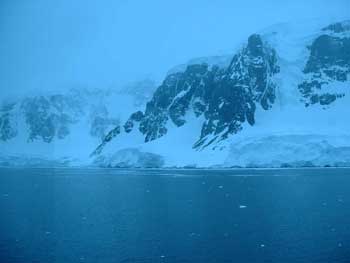
[answered by Brennan Philips, UConn graduate student] Unfortunately, this trip isn't to the South Pole... we've spent most of our time on this trip traveling around an area of Antarctica known as the Antarctic Peninsula. Antarctica is actually very large- roughly twice the size of the US. The South Pole isn't exactly in the center of it, but it is very far inland. And since the scientists on board are oceanographers, marine biologists and marine ecologists, we really don't have a reason to leave the ocean, so we've actually been on a ship the whole time. I'd imagine the South Pole would be a pretty cool place to visit, though! There is an American research station there where people live and work throughout the year. In order to get where we are, we had to travel a looonnngg way. Basically, we took a plane from one side of the earth to the other, and then took a ship and headed even further south. We first flew out of the United States and into Santiago, Chile. From there we hopped on another flight all the way south to Punta Arenas, which is a city at the very bottom of South America. There we met our ship, the Laurence M. Gould, which we've been on for the past three weeks as we travel around the Antarctic Peninsula and the series of islands that surround it.
[Story by Dr. Thomas Dahlgren of Sweden] I once heard a funny story on that theme. John, the seal researcher, was riding his Zodiac back home to the base after studying a seal colony together with his college. They had to cross an area with quite a few penguins around but maneuvered the boat slowly and with care not to harm the birds. Suddenly the penguins came shooting up from the water and sure enough, shortly after that, they saw the shadow of a leopard seal in the water. (Leopard seals are the polar bears of the Antarctic waters and are really dangerous, mostly for penguins but can also harm a man.) When leopard seals hunt penguins, the penguins try escape by jumping out of the water, and if they are near the ice edge, get on the ice and run as far from the edge as possible. So there they were sitting in their little Zodiac when it suddenly started to rain down scared penguins into their laps!! When the coast was clear, John looked at his friend, nodded and started to help the penguins back into the water.
[Editor’s note] Actually, Max, the penguins are protected down here, and there is a heavy fine to pay if you are charged with harming or disturbing a penguin. “Disturbing” means, if you are near penguins and they start to move away, or behave as though they are upset (stand up, squawk, look disturbed in any way). So, helping them into the water would not usually be allowed. They have to be left to go their merry way in any way they please. And they’re so harmless and seem so uninterested in any kind of conflict, you just sort of want to leave them be.
[Answered by Captain Michael Terminel] Good question, Max. First let me give you a little history on the R/V Laurence M. Gould. The LMG was built in Larose, Louisiana in 1997 by Edison Chouest Offshore. Raytheon Polar Services charters the vessel, which in turn provides support to the United States Antarctic Program through the National Science Foundation.
The LMG first set sail from Galliano, LA to Punta Arenas, Chile taking 27 days, and included going through the Panama Canal. The vessel is 230 feet long, 56 feet wide and drafts (how deep the bottom goes under water) 19 feet 4 inches fully loaded. It has approximately 6000 horsepower, which is equivalent to 2 locomotive train engines. Our gross tonnage, or the total weight of the ship is 2966 tons. [How they measure this is easy. Let's say you have a one gallon bucket of water filled to the top. Put a small model of a boat in the bucket. If you can catch the water that is displaced out of the bucket and weigh it, that is how much the vessel weighs. For ships as large as LMG, they do it mathematically.] She can carry 53 persons on board including crew (boats are referred to as "she"). It has a full service galley to feed everyone. On board we have a large TV room, conference room, gym, sauna and jacuzzi tub. On the Science side, we have 3 labs, an electronics lab and a main deck that can support many different operations. The LMG has a 12,000 mile range and can deploy for expeditions for up to 70 days without stopping.
The vessel is United States flagged and is inspected yearly by the United States Coast Guard and the American Bureau of Shipping (ABS). ABS is the governing agency that says what Class we are. We are Ice Class A1, meaning we are required to be able to go a speed of two knots in the "first year ice" or ice that is up to 1 meter thick. There are three ratings of Ice Breakers, A1 is the lowest, so LMG is not made to break very heavy ice. An Ice Class A3 can push through ice over 3 meters thick. On this voyage we have not encountered any ice. However, we are planning to head south today (December 11), which will bring us into heavy ice. I have attached a photo to show the capabilities of the LMG in multi-year ice.
We hope this has helped Max and others learn something about Tacky the Penguin's homeland. These questions will appear on our website, too! Ellen